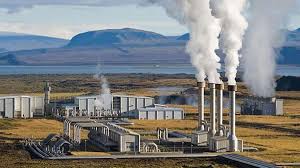When people think of renewable energy they usually think of wind and solar power first, and then maybe hydroelectric power. And those three sources of electricity, along with biomass, constitute the largest sources of renewable power in the U.S. electricity mix. But geothermal power deserves more attention than it gets.
Wind and solar are increasing their market shares because they are inexpensive, and their power output over the long run is relatively predictable, making them attractive to investors. Their output is predictable because they are first in the dispatch queue: i.e., because their operating costs are the lowest of any electric generating technology, grid operators use them to serve demand before gas-fired plants and other technologies with higher operating costs.
As wind and solar plants grow their market shares, they displace fossil fueled generators that are less weather-dependent, and available to provide power during more of the day and year. So, finding cleaner ways to “firm” or “firm up” wind and solar power — that is, to back them up when the wind isn’t blowing or the sun shining — is an important energy policy problem. When we think about the cost of firm clean power, geothermal electricity looks more attractive.
Geothermal electricity is not new. In regions of California and Nevada where geothermal resources are not far below the surface of the earth, geothermal power plants have existed since the 1960s. And the use of geothermal steam for district heating was once fairly common, particularly in places with “springs” in their name — like Hot Springs, Arkansas and Saratoga Springs, New York. The Geothermal Steam Act of 1970 (authorizing the Department of Interior to lease federal lands for geothermal development), the Public Utilities Regulatory Policies Act of 1978 (including geothermal power in a class of “alternative” energy technologies from which utilities must buy power), and the Geothermal Energy Act of 1980 (financial assistance for geothermal development) are all part of this history.
But the newest geothermal technologies — so-called “enhanced geothermal systems” — don’t rely on steam at or near the earth’s surface. Rather, they use newer drilling technologies and hydraulic fracturing to access deeper subterranean heat for power generation. That approach allows developers to produce electricity in more parts of the country. EGS injects liquid into the fracked well where it becomes superheated, then brings the superheated water to the surface under pressure, where it is turned into steam to drive a turbine. And the recent news about this new technology is very promising.
This technology is more expensive than wind and solar power, but also much less weather-dependent. Like a gas-fired power plant, it can be available to produce power day or night, in all the seasons of the year.
The most recent estimates of the levelized cost of energy estimates (LCOE)* from Lazard illustrate how marginal cost pricing disadvanteges geothermal power. Page (or slide) 15 of the Lazard document shows the estimated cost of firming up wind and solar in each of the different organized wholesale power markets in the U.S. Lazard assumes that in most of these markets, natural gas-fired plants (without carbon emission controls) will fill in the gaps when wind and solar cannot, except in CAISO (California) and PJM (mid-Atlantic states and parts of the midwest) where Lazard assumes that lithium ion batteries will provide that back up function.
The first key takeaway is this: those “solar + lithium battery” estimates far exceed the LCOE estimate for geothermal power on page (slide) #9.
But, and this is the second key takeaway, those LCOE numbers for geothermal are based on the assumption that the plant runs 80-90% of the time. If grid operators use goethermal mostly to back up wind and solar, it will be forced to recover its costs by selling fewer megawatt-hours of electricity. In that case, it must command a higher price for that energy in order to break even, and its LCOE will go up.
In this way, the success of inexpensive wind and solar comes at the expense of all the technologies that can be available more often, geothermal included. In this way, marginal cost dispatch may or may not yield the least expensive net zero system. It is possible that this increases the average cost of providing net zero electricity in competitive wholesale markets. And because geothermal would likely be used as backup power, the lack of future revenue certainty makes investors warier of investing in firm technologies.
This problem can be overcome in several ways. In states that still have traditional public utility regulation, a geothermal plant can be put in the utility’s rate base, ensuring that ratepayers will pay for it. If “base load” geothermal turns out to be less expensive than wind/solar plus backup, regulators in those traditional states can make that happen. And in some competitive power markets EGS plants might hope to earn additional revenues in capacity markets that pay them for their superior availability, or through ad hoc bilateral agreements with grid operators to ensure reliability in a mostly-renewables grid of the future. And of course, the Inflation Reduction Act offers powerful tax credits for all sorts of new energy projects, including geothermal development.
Perhaps all of this top-down encouragement can help reassure skittish investors who are wary of EGS, pumped storage hydro, nuclear power and other clean firm technologies. A carbon tax or net zero mandate would help as well. Indeed, in a world run by benevolent central planners, we might expect them to choose more clean firm technologies like EGS whose levelized costs are lower than renewables + battery storage.
But competitive wholesale power markets are not centrally planned. They rely on market competition to drive prices downward, and the growth of wind and solar is driving down spot power prices. Some pundits believe that stored solar (or wind) energy will be the cheapest backup power option, but no one knows if that will be the case. Proponents of every technology are working hard to make their product cheaper and better. Meanwhile, grid overseers must ensure a reliable supply. In the absence of regulatory limits on greenhouse gas emissions, the market will favor the cheapest backup option, whatever its carbon emissions. — David Spence
————
* “Levelized cost” is the average cost of producing power over the lifetime of the project, or the average price per mwh it must receive over its lifetime in order to break even.
** In its previous set of LCOE estimates published in April 2023 Lazard estimated the LCOE of natural gas + carbon capture and storage (CCS). Those estimates were also lower than solar + storage. However, like EGS, carbon capture technology is relatively new, and has less of a track record than utility scale solar and wind.


